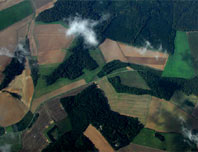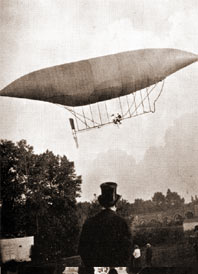My First Balloon Ascent
by Alberto Santos-Dumont
At the height of his career, the pioneering aviator Alberto
Santos-Dumont believed that flight could be a pathway to world
peace, enabling people to reflect on the all-too-human world
below and inspiring them to lead more just and moral lives.
But when he first took to the skies at the age of 24, flight
for Santos was foremost an act of adventure and joy. In the
following excerpt from his memoir My Airships, Santos
reminisces about the virgin voyage he took in 1897.
A magical stillness
I have kept the clearest remembrance of the delightful
sensations I experienced in ... my first trial in the air. I
arrived early at the Parc d'Aerostation of Vaugirard so as to
lose nothing of the preparations. The balloon, of a capacity
of 750 cubic meters [26,000 cubic feet], was lying a flat mass
on the grass. At a signal from M. Lachambre [the constructor
and owner of the balloon] the workmen turned on the gas, and
soon the formless thing rounded up into a great sphere and
rose into the air.
At 11 a.m. all was ready. The basket rocked prettily beneath
the balloon, which a mild, fresh breeze was caressing.
Impatient to be off, I stood in my corner of the narrow wicker
basket with a bag of ballast in my hand. In the other corner
M. Machuron [an experienced balloonist and Santos's guide]
gave the word: "Let go all!"
Suddenly the wind ceased. The air seemed motionless around us.
We were off, going at the speed of the air current in which we
now lived and moved. Indeed, for us, there was no more wind;
and this is the first great fact of all spherical ballooning.
Infinitely gentle is this unfelt movement forward and upward.
The illusion is complete: it seems not to be the balloon that
moves but the Earth that sinks down and away.
At the bottom of the abyss, which already opened 1,500 yards
below us, the Earth, instead of appearing round like a ball,
shows concave like a bowl by a peculiar phenomenon of
refraction whose effect is to lift up constantly to the
aeronaut's eyes the circle of the horizon.
Villages and woods, meadows and chateaux, pass across the
moving scene, out of which the whistling of locomotives throws
sharp notes. These faint, piercing sounds, together with the
yelping and barking of dogs, are the only noises that reach on
through the depths of the upper air. The human voice cannot
mount up into these boundless solitudes. Human beings look
like ants along the white lines that are highways, and the
rows of houses look like children's playthings.
The lightened balloon made a tremendous leap upward and
pierced the clouds like a cannonball.
While my gaze was still held fascinated on the scene, a cloud
passed before the sun. Its shadow cooled the gas in the
balloon, which wrinkled and began descending, gently at first,
and then with accelerated speed, against which we strove by
throwing out ballast. This is the second great fact of
spherical ballooning: we are masters of our altitude by the
possession of a few pounds of sand!
Regaining our equilibrium above a plateau of clouds at about
3,000 yards, we enjoyed a wonderful sight. The sun cast the
shadow of the balloon on this screen of dazzling whiteness,
while our own profiles, magnified to giant size, appeared in
the center of a triple rainbow! As we could no longer see the
Earth, all sensation of movement ceased. We might be going at
storm speed and not know it. We could not even know the
direction we were taking save by descending below the clouds
to regain our bearings.
An aerial picnic
A joyous peal of bells mounted up to us. It was the noonday
Angelus [a Roman Catholic call to prayer] ringing from some
village belfry. I had brought up with us a substantial lunch
of hard-boiled eggs, cold roast beef and chicken, cheese,
ice-cream, fruits and cakes, champagne, coffee and Chartreuse.
Nothing is more delicious than lunching like this above the
clouds in a spherical balloon. No dining room can be so
marvelous in its decoration. The sun sets the clouds in
ebullition, making them throw up rainbow jets of frozen vapor
like great sheaves of fireworks all around the table. Lovely
white spangles of the most delicate ice formation scatter here
and there by magic; white flakes of snow form, moment by
moment, out of nothingness, beneath our very eyes, and in our
very drinking glasses.
I was finishing my little glass of liqueur when the curtain
suddenly fell on this wonderful stage setting of sunlight,
cloud billows, and azure. The barometer rose rapidly ...
showing a sudden rapture of equilibrium and a swift descent.
Probably the balloon had become loaded down with several
pounds of snow, and it was falling into a cloud.
We passed into the half darkness of the fog. We could still
see our basket, our instruments, and the parts of the rigging
nearest us, but the netting that held us to the balloon was
visible only to a certain height, and the balloon itself had
completely disappeared. So we had for a moment the strange and
delightful sensation of hanging in the void without support,
of having lost our last ounce of weight in a limbo of
nothingness, somber and portentous.
After a few minutes of fall, slackened by throwing out more
ballast, we found ourselves under the clouds at a distance of
about 300 yards from the ground. A village fled away from us
below. We took our bearings with the compass and compared our
route map with the immense natural map that unfolded below.
Soon we could identify roads, railways, villages, and forests,
all hastening toward us from the horizon with the swiftness of
the wind itself.
The storm that had sent us downward marked a change of
weather. Now little gusts began to push the balloon from right
to left, up and down. From time to time the guide rope—a
great rope dangling 100 yards below our basket—would
touch Earth, and soon the basket also began to graze the tops
of trees.
What is called "guide-roping" thus began for me under
conditions peculiarly instructive. We had a sack of ballast at
hand, and when some special obstacle rose in our path, like a
tree or a house, we threw out a few handfuls of sand to leap
up and pass over it. More than 50 yards of the guide rope
dragged behind us on the ground, and this was more than enough
to keep our equilibrium under the altitude of 100 yards, above
which we decided not to rise for the rest of the trip.
Learning the ropes
This first ascent allowed me to appreciate fully the utility
of this simple part of the spherical balloon's rigging,
without which its landing would usually present grave
difficulties. When, for one reason or another—humidity
gathering on the surface of the balloon, a downward stroke of
wind, accidental loss of gas, or, more frequently, the passing
of a cloud before the face of the sun—the balloon came
back to Earth with disquieting speed, the guide rope would
come to rest in part on the ground, and so, unballasting the
whole system by so much of its weight, stopped, or at least
eased, the fall. Under contrary conditions, any too rapid
upward tendency of the balloon was counterbalanced by the
lifting of the guide rope off the ground, so that a little
more of its weight became added to the weight of the floating
system of the moment before.
It was losing the remains of its gas in convulsive agitations,
like a great bird that dies in beating its wings.
Like all human devices, however, the guide rope, along with
its advantages, has its inconveniences. Its rubbing along the
uneven surfaces of the ground—over fields and meadows,
hills and valleys, roads and houses, hedges and telegraph
wires—gives violent shocks to the balloon. Or it may
happen that the guide rope, rapidly unraveling the snarl in
which it has twisted itself, catches hold of some asperity of
the surface or winds itself around the trunk or branches of a
tree....
As we passed a little group of trees, a shock stronger than
any hitherto felt threw us backward in the basket. The balloon
had stopped short and was swaying in the wind gusts at the end
of its guide rope, which had curled itself around the head of
an oak. For a quarter of an hour it kept shaking like a salad
basket, and it was only by throwing out a quantity of ballast
that we finally got ourselves loose. The lightened balloon
made a tremendous leap upward and pierced the clouds like a
cannonball. Indeed, it threatened to reach dangerous heights,
considering the little ballast we had remaining in store for
use in descending. It was time to have recourse to effective
means, to open the maneuver valve and let out a portion of our
gas.
It ... [took only] a moment. The balloon began descending to
Earth again, and soon the guide rope again rested on the
ground. There was nothing to do but to bring the trip to an
end, because only a few handfuls of sand remained to us.
A smooth landing
He who wishes to navigate an airship should first practice a
good many landings in a spherical balloon—that is, if he
wishes to land without breaking balloon, keel, motor, rudder,
propeller, water-ballast cylinders, and fuel holders. The wind
being rather strong, it was necessary to seek shelter for this
last maneuver. At the end of the plain ... the forest of
Fontainebleau was hurrying toward us. In a few moments we had
turned [toward] the extremity of the wood, sacrificing our
last handful of ballast. The trees now protected us from the
violence of the wind, and we cast anchor, at the same time
opening wide the emergency valve for the wholesale escape of
the gas.
The twofold maneuver landed us without the least dragging. We
set foot on solid ground and stood there watching the balloon
die. Stretched out in the field, it was losing the remains of
its gas in convulsive agitations, like a great bird that dies
in beating its wings.
After taking a dozen instantaneous photographs of the dying
balloon, we folded it and packed it in the basket with its
netting folded alongside. The little chosen corner in which we
had landed formed part of the grounds of the Chateau de la
Ferrière, belonging to M. Alphonse de Rothschild.
Laborers from a neighboring field were sent for a conveyance
to the village of La Ferrière itself, and half an hour
later a brake [a farming vehicle] came. Putting everything
into it, we set off to the railway station, which was some two
miles distant. There we had some work to lift the basket with
its contents to the ground, as it weighed 200 kilograms [440
pounds]. At 6:30 p.m. we were back in Paris, after a journey
of 100 kilometers [62 miles] and nearly two hours passed in
the air.
I liked ballooning so much that, coming back from my first
trip with M. Machuron, I told him that I wanted a balloon
built for myself.








